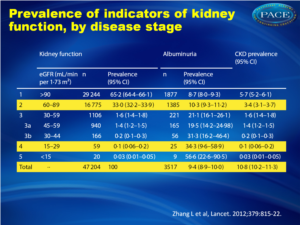Chronic kidney disease increasing in China
The China National Survey of Chronic Kidney disease was a cross-sectional study to evaluate the prevalence of CKD and associated factors in Chinese adults between 2007 and 2010.CKD has become an important public health issue in China, maybe as a consequence of increased diabetes and hypertension. Economically improving rural areas should be closely monitored...
Prevalence of chronic kidney disease in China: a cross-sectional surveyLiterature - Zhang L et al, Lancet. 2012;379:815-22
Zhang L, Wang F, et al.
Lancet. 2012;379:815-22.
Background
Chronic kidney disease (CKD) is an increasing health problem. Through its effect on CV risk and outcomes and on end-stage renal disease, CKD directly affects the global burden of CV death, the most common cause of premature morbidity and mortality [1]. In developing countries, CKD is increasing due to a rapid increase in the prevalence of risk factors such as diabetes, hypertension, and obesity, and will have substantial socioeconomic and public health consequences [2]. As China is a developing country with great heterogeneity, the prevalence of CKD varies between geographical regions [3-6]. No national survey has been done incorporating both estimated glomerular filtration rate (eGFR) and albuminuria. The China National Survey of Chronic Kidney disease was a cross-sectional study to evaluate the prevalence of CKD and associated factors in Chinese adults between 2007 and 2010.
Methods
A cross-sectional survey was performed in 47 204 Chinese adults. Serum creatinine was measured to estimate eGFR; albuminuria was assessed using urinary albumin and creatinine.
Main results
- Adjusted prevalence of eGFR < 60 mL/min per 1.73 m2: 1.7 % (95% CI 1.5-1.9)
- Albuminuria prevalence: 9.4% (8.9-10.0)
- Adjusted prevalence of CKD: 10.8% (10.2-11.3)
- In rural areas fewer eGFR < 60 mL/min/1.73 m2 than in urban areas, more albuminuria in rural areas
- Prevalence of CKD highly variable between geographical regions (higher in north and southwest China)
- Factors associated with kidney damage: age, sex, hypertension, diabetes, CV disease history, hyperuricaemia, area of residence, economic status
Conclusion
CKD has become an important public health issue in China, maybe as a consequence of increased diabetes and hypertension. Economically improving rural areas should be closely monitored.
References
1. Bello AK, Nwankwo E, El Nahas AM. Prevention of chronic kidney disease: a global challenge. Kidney Int Suppl 2005; 98: S11–17.2. Nugent RA, Fathima SF, et al. The burden of chronic kidney disease on developing nations: a 21st century challenge in global health. Nephron Clin Pract 2011; 118: c269–77.
3. Chen N, Wang W, Huang Y, et al. Community-based study on CKD subjects and the associated risk factors. Nephrol Dial Transplant 2009; 24: 2117–23.
4. Chen W, Liu Q, Wang H, et al. Prevalence and risk factors of chronic kidney disease: a population study in the Tibetan population. Nephrol Dial Transplant 2011; 26: 1592–99.
5. Chen W, Wang H, Dong X, et al. Prevalence and risk factors associated with chronic kidney disease in an adult population from southern China. Nephrol Dial Transplant 2009; 24: 1205–12.
6. Zhang L, Zhang P, Wang F, et al. Prevalence and factors associated with CKD: a population study from Beijing. Am J Kidney Dis 2008;51: 373–84.
Abstract
Background:The prevalence of chronic kidney disease is high in developing countries. However, no national survey of chronic kidney disease has been done incorporating both estimated glomerular filtration rate (eGFR) and albuminuria in a developing country with the economic diversity of China. We aimed to measure the prevalence of chronic kidney disease in China with such a survey.
Methods:
We did a cross-sectional survey of a nationally representative sample of Chinese adults. Chronic kidney disease was defined as eGFR less than 60 mL/min per 1•73 m(2) or the presence of albuminuria. Participants completed a lifestyle and medical history questionnaire and had their blood pressure measured, and blood and urine samples taken. Serum creatinine was measured and used to estimate glomerular filtration rate. Urinary albumin and creatinine were tested to assess albuminuria. The crude and adjusted prevalence of indicators of kidney damage were calculated and factors associated with the presence of chronic kidney disease analysed by logistic regression.
Findings:
50,550 people were invited to participate, of whom 47,204 agreed. The adjusted prevalence of eGFR less than 60 mL/min per 1•73 m(2) was 1•7% (95% CI 1•5-1•9) and of albuminuria was 9•4% (8•9-10•0). The overall prevalence of chronic kidney disease was 10•8% (10•2-11•3); therefore the number of patients with chronic kidney disease in China is estimated to be about 119•5 million (112•9-125•0 million). In rural areas, economic development was independently associated with the presence of albuminuria. The prevalence of chronic kidney disease was high in north (16•9% [15•1-18•7]) and southwest (18•3% [16•4-20•4]) regions compared with other regions. Other factors independently associated with kidney damage were age, sex, hypertension, diabetes, history of cardiovascular disease, hyperuricaemia, area of residence, and economic status.
Interpretation:
Chronic kidney disease has become an important public health problem in China. Special attention should be paid to residents in economically improving rural areas and specific geographical regions in China.

